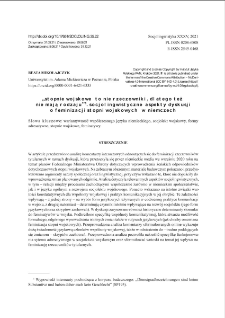- Search in all Repository
- Literature and maps
- Archeology
- Mills database
- Natural sciences
Advanced search
Advanced search
Advanced search
Advanced search
Advanced search

Object
Title: "Military Ranks Are not Nouns, therefore, They Cannot Be Classified by Grammatical Gender". Sociolinguistic Aspects of the Discussion on Feminisation of Military Ranks in Germany
Publisher:
Instytut Języka Polskiego Polskiej Akademii Nauk
Place of publishing:
Abstract:
The article analyses internet comments concerning feminised forms of address triggered as a result of the discussion that took place in German media in September 2020 regarding the plans of German Federal Ministry of Defence to introduce feminised equivalents of existing military ranks. The article presents the collected research material and discusses its social and linguistic arguments that have led to the decision of not introducing top-down planned changes. The analysis deals with relevant sociolingustic aspects incl. relations that currently take place in processes both within German society and in standard language vs the development of military sociolect. Moreover, the article indicates crucial dependencies between constitutive values for military community and communicative practices of this community. Those dependencies, on the one hand, influence the choice of linguistic forms used daily in military communication and, on the other hand, determine factors that have an impact on the development of the sociolect (its linguistic forms and behavioral scripts). The article also presents historical determinants that provoke certain approach to feminised forms in the military. Furthermore, the article highlights the character of communicative community which creates the opportunity to introduce crucial changes (also in linguistic routines such as the discussed introduction of feminised equivalents of existing military ranks) in a formal, top-down manner. The conducted analysis of internet comments displays a significant linguistic awareness of military community members also related to behavioral scripts that tend to be difficult to change. The said analysis allows to define the specificity of how the addressing system functions in military sociolect and its impact on creating feminised forms of address.
References:
Bąk, P. 2013. „Poprawność polityczna a problem ekwiwalencji polskich i niemieckich żeńskich nazw oso-bowych”. Lingwistyka Stosowana. Applied Linguistics. Angewandte Linguistik 8: 27–41.
Carreiras, H., i G. Kümmel. 2008. Women in the Military and in Armed Conflict. Wiesbaden: Springer VS.
Cieszkowski, M. 2015. „Zum geschlechtergeregelten Sprachgebrauch am Beispiel deutscher und polnischer Stellenausschreibungen”. Linguistik Online 70 (1): 23–42.
Dargiewicz, A. 2021. „Ist das Polnische eine geschlechtergeregelte Sprache? Zur Movierung im Polnischen”. Prace Językoznawcze 23 (1): 179–198.
Diewald, G., i A. Steinhauer. 2020. Handbuch geschlechtergerechte Sprache. Berlin: Duden.
Grabias, S. 2019. Język w zachowaniach społecznych, wyd. 10 popr. Lublin: Wydawnictwo Uniwersytetu
Marii Curie-Skłodowskiej.
Relation:
Volume:
Start page:
End page:
Detailed Resource Type:
Format:
Resource Identifier:
click here to follow the link ; oai:rcin.org.pl:233337
Language:
Language of abstract:
Rights:
Terms of use:
Copyright-protected material. May be used within the limits of statutory user freedoms
Access:
Object collections:
- Digital Repository of Scientific Institutes > Partners' collections > Institute of Polish Language PAS
- Digital Repository of Scientific Institutes > Partners' collections > Institute of Polish Language PAS > Serials
- Digital Repository of Scientific Institutes > Partners' collections > Institute of Polish Language PAS > Filds of science > Humanities > Linguistics > Sociolinguistics
- Digital Repository of Scientific Institutes > Partners' collections > Institute of Polish Language PAS > Offprint
- Digital Repository of Scientific Institutes > Literature > Journals/Articles
- Digital Repository of Scientific Institutes > Scientific data and objects > Humanities and Social Sciences > IJP PAN files
Last modified:
Jan 26, 2022
In our library since:
Jan 26, 2022
Number of object content downloads / hits:
1167
All available object's versions:
https://rcin.org.pl./publication/270357
Show description in RDF format:
Show description in RDFa format:
Show description in OAI-PMH format:
Objects Similar
Nasalski, Ignacy

 INSTYTUT ARCHEOLOGII I ETNOLOGII POLSKIEJ AKADEMII NAUK
INSTYTUT ARCHEOLOGII I ETNOLOGII POLSKIEJ AKADEMII NAUK
 INSTYTUT BADAŃ LITERACKICH POLSKIEJ AKADEMII NAUK
INSTYTUT BADAŃ LITERACKICH POLSKIEJ AKADEMII NAUK
 INSTYTUT BADAWCZY LEŚNICTWA
INSTYTUT BADAWCZY LEŚNICTWA
 INSTYTUT BIOLOGII DOŚWIADCZALNEJ IM. MARCELEGO NENCKIEGO POLSKIEJ AKADEMII NAUK
INSTYTUT BIOLOGII DOŚWIADCZALNEJ IM. MARCELEGO NENCKIEGO POLSKIEJ AKADEMII NAUK
 INSTYTUT BIOLOGII SSAKÓW POLSKIEJ AKADEMII NAUK
INSTYTUT BIOLOGII SSAKÓW POLSKIEJ AKADEMII NAUK
 INSTYTUT CHEMII FIZYCZNEJ PAN
INSTYTUT CHEMII FIZYCZNEJ PAN
 INSTYTUT CHEMII ORGANICZNEJ PAN
INSTYTUT CHEMII ORGANICZNEJ PAN
 INSTYTUT FILOZOFII I SOCJOLOGII PAN
INSTYTUT FILOZOFII I SOCJOLOGII PAN
 INSTYTUT GEOGRAFII I PRZESTRZENNEGO ZAGOSPODAROWANIA PAN
INSTYTUT GEOGRAFII I PRZESTRZENNEGO ZAGOSPODAROWANIA PAN
 INSTYTUT HISTORII im. TADEUSZA MANTEUFFLA POLSKIEJ AKADEMII NAUK
INSTYTUT HISTORII im. TADEUSZA MANTEUFFLA POLSKIEJ AKADEMII NAUK
 INSTYTUT JĘZYKA POLSKIEGO POLSKIEJ AKADEMII NAUK
INSTYTUT JĘZYKA POLSKIEGO POLSKIEJ AKADEMII NAUK
 INSTYTUT MATEMATYCZNY PAN
INSTYTUT MATEMATYCZNY PAN
 INSTYTUT MEDYCYNY DOŚWIADCZALNEJ I KLINICZNEJ IM.MIROSŁAWA MOSSAKOWSKIEGO POLSKIEJ AKADEMII NAUK
INSTYTUT MEDYCYNY DOŚWIADCZALNEJ I KLINICZNEJ IM.MIROSŁAWA MOSSAKOWSKIEGO POLSKIEJ AKADEMII NAUK
 INSTYTUT PODSTAWOWYCH PROBLEMÓW TECHNIKI PAN
INSTYTUT PODSTAWOWYCH PROBLEMÓW TECHNIKI PAN
 INSTYTUT SLAWISTYKI PAN
INSTYTUT SLAWISTYKI PAN
 SIEĆ BADAWCZA ŁUKASIEWICZ - INSTYTUT TECHNOLOGII MATERIAŁÓW ELEKTRONICZNYCH
SIEĆ BADAWCZA ŁUKASIEWICZ - INSTYTUT TECHNOLOGII MATERIAŁÓW ELEKTRONICZNYCH
 MUZEUM I INSTYTUT ZOOLOGII POLSKIEJ AKADEMII NAUK
MUZEUM I INSTYTUT ZOOLOGII POLSKIEJ AKADEMII NAUK
 INSTYTUT BADAŃ SYSTEMOWYCH PAN
INSTYTUT BADAŃ SYSTEMOWYCH PAN
 INSTYTUT BOTANIKI IM. WŁADYSŁAWA SZAFERA POLSKIEJ AKADEMII NAUK
INSTYTUT BOTANIKI IM. WŁADYSŁAWA SZAFERA POLSKIEJ AKADEMII NAUK




































